Tutoring Tools for Children with ADHD & Sensory Conditions | Synergize Learning
Creating a supportive sensory environment is crucial for academic success
Academic success for young learners is largely dependent upon their ability to attend to directions and tasks. However, students with ADHD and sensory conditions may have difficulties concentrating, sitting still for long periods of time, following directions, and managing their impulsivity – all of which may impact their academic success. By giving learners means to fidget in ways that do not disrupt learning, they are set up to work to their full potential.
There are many tools we’ve recommended to our families, which can help students who may have ADHD or other sensory conditions in academic settings such as tutoring or even within the classroom.
Struggling to Sit Still
For most learners, sitting still for long periods of time can be difficult; for students with ADHD and Sensory Conditions, remaining seated for most of the day can be especially challenging.
Sensory seats and
chair bands are designed to allow students to move their bodies and/or feet to release energy in a non-distracting way, which in turn helps them remain seated during academic tasks.

Restless Hands
When a student with ADHD or sensory conditions are feeling restless, overstimulated, or anxious, they may begin to fidget with their body more and more. However, by providing them with physical manipulatives or fidgets, can help soothe overstimulated brains, increase self-regulation, and improve a learner’s concentration.
There so many different fidgets to choose from, but here are a few we especially recommend:
Sustaining Attention
Sustaining attention for long periods of time can be difficult for young learners with ADHD and Sensory Conditions as they may not perceive time the way that adults do. For example, if a student is told that a task will take 20 minutes to complete, they may perceive those 20 minutes to feel like an eternity. However, by helping the student have a
visual timer to refer to over the course of the 20 minute period, they may come to find that time moved more quickly than they thought it would! Students may also benefit from a
visual schedule so they can note the tasks or things they must complete – this helps students know what tasks they will be doing and in what order, allowing them to anticipate an upcoming task.
Auditory Overload
Some students may need tools to assist with auditory overstimulation, which can impact their behavior and engagement in academic tasks.
Noise reducing headphones that are designed to be worn over ears for comfort can be beneficial for virtual learning. Additionally,
white noise machines can also be used to reduce auditory distractions and help increase a learner’s focus during academic tasks.
Get your student the help they need today!
All Rights Reserved | Synergize Learning LLC
Legal Disclosure: Synergize Learning LLC is neither Lindamood-Bell Learning Processes nor is it affiliated with, certified, endorsed, licensed, monitored or sponsored by Lindamood-Bell, Nanci Bell, Phyllis Lindamood or Pat Lindamood. Lindamood-Bell--an international organization creating and implementing unique instructional methods and programs for quality intervention to advance language and literacy skills--in no way endorses or monitors the services provided by Synergize Learning LLC.
